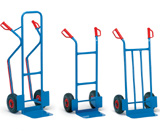 Over a third of injuries that keep people off work for more than three days at a time are caused by manual handling – falls and trips account for much of the rest. As a consequence there are many regulations governing activities such as pulling, pushing, carrying, lifting and loading. The following provides some suggestions on how to improve manual handling techniques and reduce accidents.
Over a third of injuries that keep people off work for more than three days at a time are caused by manual handling – falls and trips account for much of the rest. As a consequence there are many regulations governing activities such as pulling, pushing, carrying, lifting and loading. The following provides some suggestions on how to improve manual handling techniques and reduce accidents.
The first thing to consider is whether the object needs handling at all – can the process be mechanised or made easier with handling aids such as sack trucks, pallet trucks, conveyors or other lifting devices. Has there been sufficient training for the person doing the moving, whether this involves the type of load, mechanical aids or other risk factors? Before doing any lift or handling of an awkward item it is advisable to have some kind of plan of action – this can include simple things such as removing obstacles out of the way or checking for potential trip hazards. For a particularly difficult item, consider if there is somewhere to take a short rest if required (like a table or bench) and make sure this doesn't block access for other people.
For the lift of an item, the starting posture is important and you should adopt a slight bend of the back, hips and knees rather than fully flexing the back. Avoid twisting the back and keep shoulders level and facing the same direction as the hips. Look ahead - certainly avoid looking down - and try and maintain a smooth action throughout the movement. The most important thing is not to attempt to lift too much and if in any doubt try and share the load with someone else or seek other advice. When putting an object down, bend the knees and maintain a straight or slightly bending back – the focus should be on getting the object down on the ground and then adjust it to the correct position.
If you are handling something that needs to be pushed or pulled then you will probably be using a trolley or a hand truck. When purchasing a hand or sack truck, ensure that it has good quality wheels made of suitable materials with casting and bearings that require minimum maintenance. Cheap sack trucks rarely save money as they will get damaged easily and need replacing – it won't be cost effective to fix them so the best idea is to purchase a quality hand truck in the first place. The better class of trucks will also come into their own on surfaces which are soft, sloping or uneven and involve heavier weights. Clearly a budget or basic sack truck will have a limited load capacity (around 100 kg) whereas sturdier hand trucks can be designed to take loads of up to 400kg. A sack or hand truck should just be pushed forward as opposed to office or warehouse trolleys which can often be pulled. One other consideration with hand trucks, especially for deliverymen, is whether they can be folded (for use in vehicle) and ideally made from aluminium which makes them lighter than a typical truck.
You can get further information on manual handling from the hse.gov.uk website where you can find case study material about handling assessment and online training in the use of Manual Handling Assessment Charts. There are also a number of HSE publications widely available from Bookshops
Posted in News, Warehouse, Office, Health and Safety